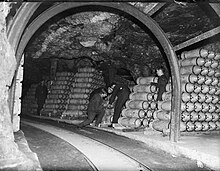Explosion in the RAF ammunition depot in Fauld
Coordinates: 52 ° 50 ′ 51 ″ N , 1 ° 43 ′ 51 ″ W.
The RAF Fauld ammunition dump explosion was an explosion at a Royal Air Force (RAF) ammunition dump near Burton upon Trent on November 27, 1944. The explosion was one of the largest man-made, non-nuclear explosions in history and the largest in the United States Kingdom. Between 3500 and 4000 tons of ammunition exploded. The majority of these were high- explosive bombs , but also a large number of other ammunition, including 500 million rounds of rifle ammunition.
root cause
A cause for the accident was not given for the time being. At the time of the accident, there was a shortage of staff. A managerial position had not been filled for a year and 189 inexperienced Italian prisoners of war worked in the camp. In 1974 it was revealed that the possible cause was removing a detonator with a brass chisel. An eyewitness said he saw workers using brass chisels instead of the strictly prescribed wooden tools.
Effects
Two large explosions shook the ammunition depot on November 27, 1944 at 11:15 am. Eyewitnesses reported two pillars of smoke in the form of mushroom clouds that rose to several thousand feet and flames at the bottom of the pillars. According to the report of the Commanding Officer of 21 MU (Group Captain Storrar), an open store of incendiary bombs caught fire, but burned down without causing further damage. About a third of the ammunition depot exploded. Rock between sections 3 and 4 prevented the entire depot from being captured.
The area affected was around the ammunition depot with a radius of around 1300 m. In the gypsum works to the north, a reservoir with a volume of 450,000 m³ broke and the tidal wave caused further damage. The Upper Castle Hayes farm was completely destroyed. Several other farms were badly damaged. There was also damage from falling debris in the nearby village of Hanbury. A crater was created with an area of 270 m × 213 m and a depth of 30 m
Victim
As there is no exact record of the number of workers in the camp, the exact number of deaths is not known. It is estimated that around 70 people died in the explosion. The official report speaks of 90 dead, missing and injured. This includes:
- 26 dead or missing in the ammunition dump, distributed among RAF personnel, civilian workers and some Italian prisoners of war. 5 of them died from poisonous gases; 10 seriously injured.
- 37 dead or missing in the nearby gypsum mine, the associated gypsum mill and the surrounding area; 12 injured.
- Possibly about 7 workers from a nearby farm.
In addition, 200 cattle were killed in the explosion. Some cattle were rescued from the area, but were dead the next morning.
Follow-up time
Most of the ammunition dump was destroyed by the explosion. The military facility was used by the RAF as an ammunition depot until 1966. After France withdrew from the military integration of NATO in 1966, the United States Army used the facility between 1967 and 1973 as a warehouse for ammunition that had previously been stored in France.
In 1979 the site of the accident was fenced in and the crater is now mostly overgrown with trees. Entry is prohibited as there are still large amounts of unexploded ammunition there. A disposal of the ordnance is not planned for cost reasons.
There are a number of paintings by David Bomberg under the common title "the bomb store", which were created in 1942 when he was a war painter for a short time .
Web links
literature
- "Britain's big bang" by Peter Grego, Astronomy Now , November 2004. ISSN 0951-9726 .
- McCamley, NJ (1998). Secret Underground Cities . Barnsley: Leo Cooper. ISBN 0-85052-585-3 .
- McCamley, NJ (2004). Disasters underground . Barnsley: Pen & Sword Military. ISBN 1-84415-022-4 .
- Hardy, Valerie. (2015). Voices from the Explosion: RAF Fauld, the World's Largest Accidental Blast, 1944 . ISBN 978-1-911121-03-9
- McCamley, NJ (2015). "The Fauld Disaster November 27, 1944" Folly Books. ISBN 978-0-9928554-3-7
Individual evidence
- ↑ WW2 People's War - War Memories - with a song and dance and a huge explosion . BBC. October 24, 2005. Retrieved August 1, 2016.
- ^ A b c Ministry of Home Security report File RE. 5 / 5i region IX.
- ^ Mark Rowe: World's largest-ever explosion (almost) . BBC Stoke. August 29, 2008. Retrieved April 1, 2019.
- ↑ Tony Waltham: Landmark of geology in the East Midlands: The explosion crater at Fauld . In: Mercian Geologist . 15, No. 2, 2001, pp. 123-125. Retrieved April 1, 2019.
- ↑ a b Jane Goddard: Bygones: Book coincides with 70th anniversary of giant explosion at RAF Fauld, near Burton . In: Derby Telegraph , October 6, 2014. Archived from the original on July 11, 2015. Retrieved April 1, 2019.
- ^ A b Reed, John, (1977). "Largest Wartime Explosions: 21 Maintenance Unit, RAF Fauld, Staff. November 27, 1944", After the Battle , 18 , pp. 35-40. ISSN 0306-154X .
- ↑ File no RE5 / 5 region IX, now held by The National Archives as AIR 17/10
- ↑ Member countries . NATO. July 9, 2009. Retrieved July 15, 2009.
- ↑ David Bell: 8 . In: Staffordshire Tales of Murder & Mystery (= Murder & Mystery). Countryside Books, 2005, ISBN 1-85306-922-1 , p. 78.
- ^ Richard Cork: David Bomberg . Yale University Press, 1986, ISBN 978-0-300-03827-9 .

